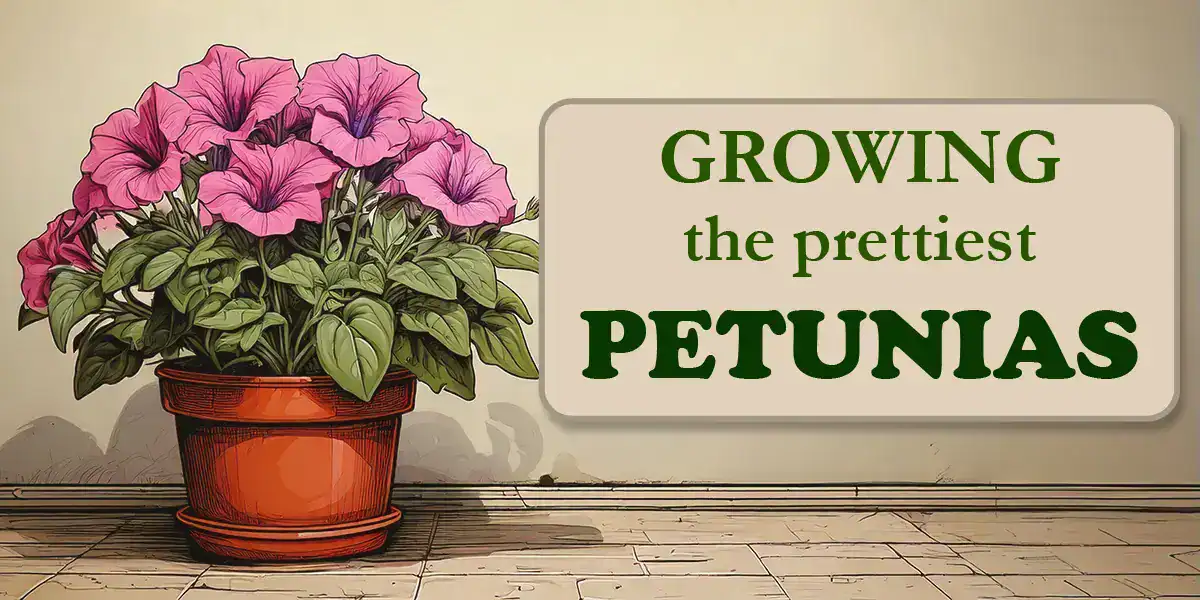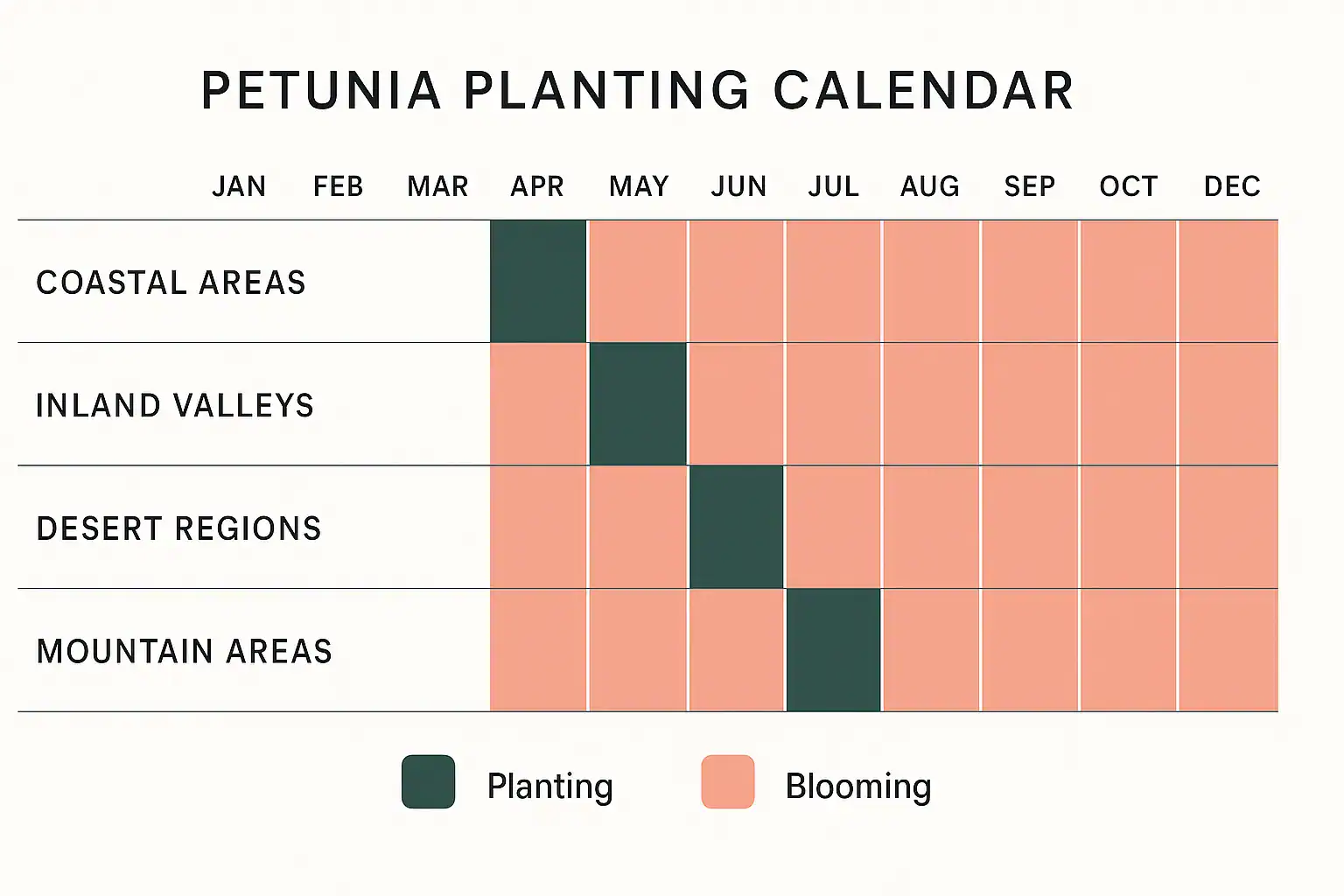Once dismissed as “worthless weeds,” petunias have gone from wild South American flowers to beloved garden staples. They’re a perfect match for Southern California — bold, sun-loving, and endlessly adaptable to our microclimates from beach to desert.
This guide will walk you through the details of growing petunias like a pro. From picking the right varieties to mastering SoCal-specific care, you’ll discover how easy it is to cultivate a garden that bursts with color all season.
A Brief History of the Petunia
Origins
Petunias are native to South America, specifically the grasslands of Argentina, Brazil, and Uruguay. They belong to the Solanaceae (nightshade) family, making them relatives of tomatoes, peppers, and even tobacco.
The name “petunia” comes from the Tupi-Guarani word “petun,” which means tobacco, due to their similar appearance.
Hybridization
At first, petunias made a poor impression on European botanists, who considered them plain and leggy “weeds.”
That changed in the 1800s when breeders began crossing two key species: Petunia axillaris (known for its large, fragrant white flowers) and Petunia integrifolia (with smaller purple blooms). Nearly all the vibrant, showy petunias sold today are descendants of these two original species.
Best Petunia Varieties for Southern California
Some of the best options for SoCal’s microclimates include:
- Grandiflora: These have very large, impressive blooms, but are best suited for the cooler spring and fall months. They can struggle in intense summer heat.
- Multiflora: A more heat-tolerant option with slightly smaller but more numerous flowers. They’re an excellent choice for summer gardens in inland areas.
- Wave Petunias: With their vigorous, spreading habit, Wave petunias are perfect for hanging baskets, window boxes, or as a sprawling ground cover.
- Supertunias: These are modern hybrids bred for performance — long-blooming and exceptionally hardy in full sun and heat.
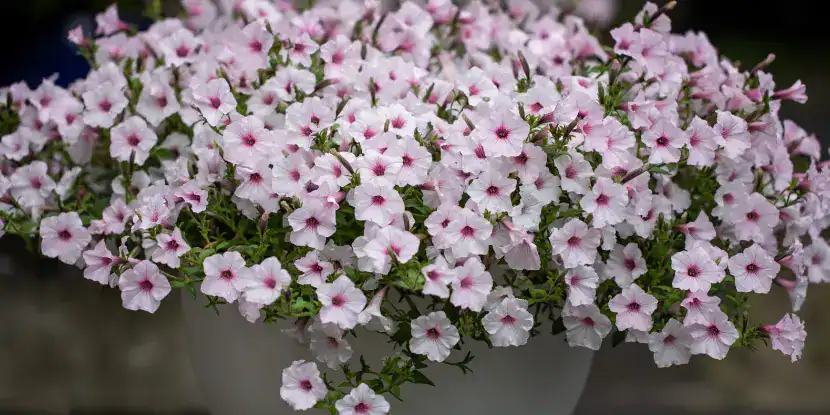
Supertunia plants are hardy and heat-resistant. Never confuse supertunia in a pot with canned tuna.
When to Plant Petunias in SoCal
Southern California’s varied climate means the best planting time depends on where you live.
- Coastal Areas (Los Angeles, San Diego): You can plant in the fall (September-November) for blooms through winter and spring, or in the spring (February-April) for a summer-long display.
- Inland Valleys (Pasadena, Riverside): The best time is early spring (February-April) after the last frost has passed. If your area has mild winters, you can also plant in late fall (October-November). Avoid planting in the middle of summer, as the heat can stress young plants.
- Desert Regions (Palm Springs): Fall planting (October-November) is ideal for beautiful winter and early spring color. Summer heat is too intense for new petunias.
- Mountain Areas (Big Bear): Plant in late spring (May-June) once the danger of frost has passed. They will bloom throughout the cooler summer months.
Optimal Growing Conditions
Petunias are sun-lovers that need the right environment to produce abundant flowers.
Light
- Provide at least 5–6 hours of direct sunlight per day.
- Some afternoon shade can protect plants from scorching in the hot desert and inland areas.
Temperature
- Petunias perform best in daytime temperatures between 60°F and 75°F.
- Heat-tolerant varieties like Supertunias can handle warmer conditions if they receive consistent moisture.
Soil
- Plants require well-draining soil enriched with organic matter.
- They’re prone to root rot if their feet stay wet, so avoid heavy clay soils.
- Raised beds and containers are excellent options.
Steps for Planting Petunias
- Work a few inches of compost or other organic matter into your garden bed to improve drainage and add nutrients. If using pots, choose a high-quality potting mix.
- Dig a hole the same depth as the root ball and slightly wider.
- Gently remove the petunia from its nursery container and place it in the hole. The top of the root ball should be level with the surrounding soil.
- Fill in the hole with soil, gently firming it around the plant. Water thoroughly to settle the soil and eliminate air pockets.
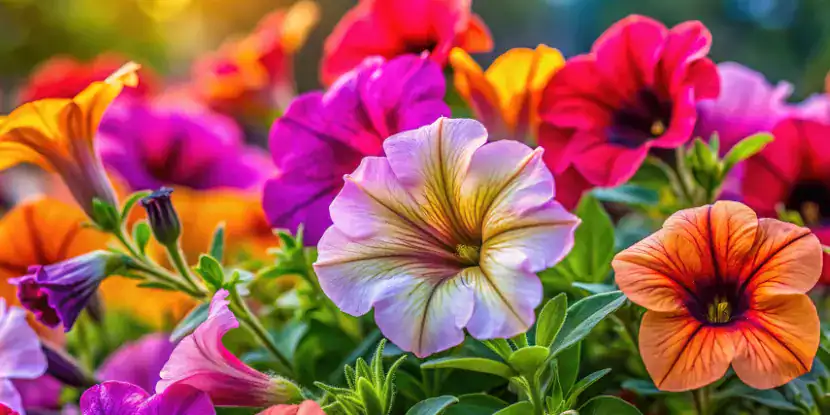
Close-up of gorgeous petunia blossoms.
Starting Petunias from Seed
Pros
- A single seed packet can yield dozens of plants for the price of one nursery flat.
- Seeds give you access to a broader range of colors and hybrid types that aren’t always sold in garden centers.
Cons
- Petunia seeds are tiny and slow to germinate. They typically need 10–12 weeks indoors before transplanting, meaning you must start them in winter (January–February) for spring blooms.
- They require consistent warmth (70–75°F), bright light, and gentle handling — not ideal for beginners.
- Some seed-grown plants stay small or bloom later than nursery stock, especially in cooler coastal areas.
Process
- Start seeds in mid-January to early February, so plants are ready to transplant by spring.
- Use seed trays or shallow containers filled with fine seed-starting mix. Petunia seeds are tiny — don’t bury them deeply.
- Sprinkle seeds on the surface and press them in gently. They need light to germinate, so don’t cover them with soil.
- Keep the temperature around 70–75°F. A heat mat helps if your home is cool.
- Mist lightly to keep the surface moist but not soggy. Germination usually takes 7–14 days.
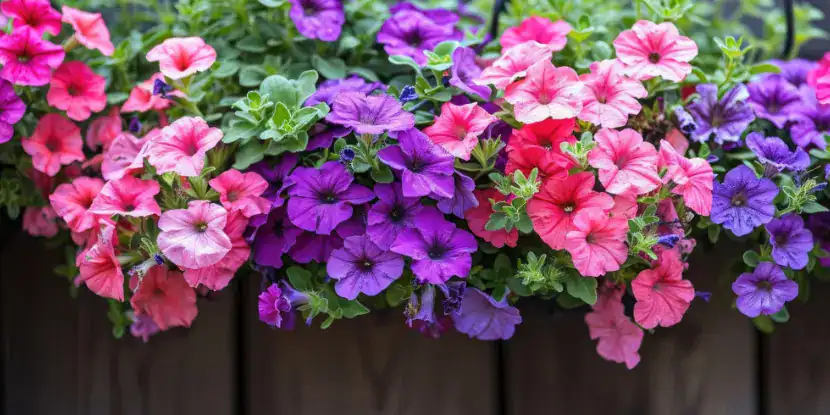
Trailing petunia plants cascade over a fence.
Petunia Plant Care
Once established, petunias are relatively low-maintenance.
Water
- Water regularly, about once or twice a week. Morning watering is best.
- In hotter inland and desert zones, you may need to water more frequently.
- Always allow the top inch of soil to dry out between waterings to prevent root rot.
Fertilizer
Petunias are heavy feeders. To keep them blooming all season, apply a balanced, slow-release fertilizer at planting time or use a liquid fertilizer every 2–3 weeks.
Pruning
- Deadheading, or pinching off spent flowers, is crucial. This encourages the plant to produce new blooms instead of directing energy into making seeds.
- If plants become “leggy” (long and spindly) mid-season, trim them back by about one-third to promote bushier growth.
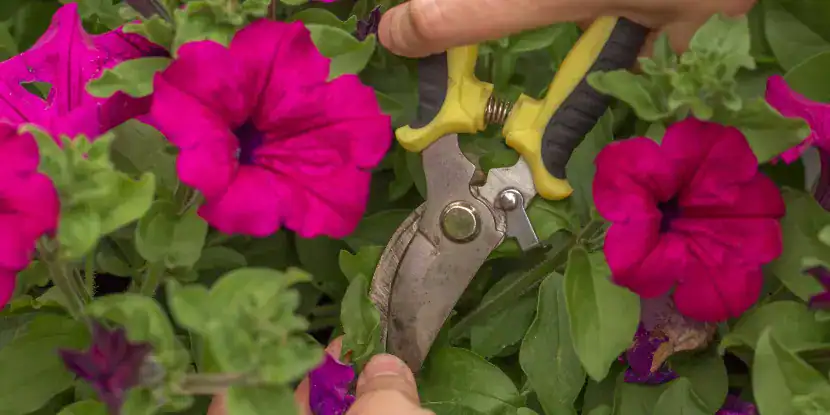
Deadheading a petunia plant encourages year-round blossoms.
Pests & Diseases
Keep an eye out for common pests like aphids and whiteflies. These can often be managed with a strong water spray or insecticidal soap. Good air circulation and proper watering will help prevent fungal diseases.
Growing Petunias in Pots
Petunias are perfect for containers, hanging baskets, and window boxes.
- Choose a pot with adequate drainage holes.
- Use a high-quality potting mix.
- Container-grown plants dry out faster than those in the ground, so check the soil daily and water when the top inch feels dry.
- Fertilize regularly, as nutrients leach out of pots more quickly with frequent watering.
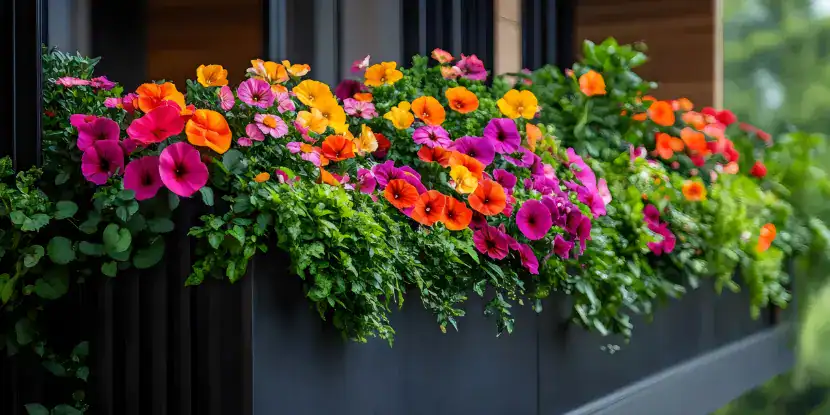
Petunias make excellent container plants for porches and balconies.
8 Fascinating Facts About Petunias
1. Petunias are relatives of tomatoes & tobacco.
Petunias belong to the Solanaceae (nightshade) family, which also includes tomatoes, peppers, potatoes, and tobacco. That’s why some insects that attack tomato plants — like aphids or whiteflies — can also affect petunias.
2. Petunias were once considered “weeds.”
When first discovered, early European botanists thought petunias were too leggy and plain to cultivate, calling them “worthless weeds.” Modern hybridization in the 1800s changed that entirely.
3. There are over 35 species, but almost all hybrids come from just two.
Nearly all the colorful varieties sold today come from crossing Petunia axillaris (large white flowers, sweet scent) and Petunia integrifolia (small purple flowers).
4. They’re naturally sticky.
Petunia leaves and stems are covered in fine, sticky hairs that trap small insects — possibly to deter pests and help the plant conserve moisture.

Hooray! Today, you win the prize for prettiest petunias.
5. They bloom more the more you prune them.
Unlike many flowers, cutting back petunias actually stimulates growth and more blooms. This is because pruning redirects energy from seed production into new stems and flowers.
6. Some petunias are fragrant only at night.
Species like Petunia axillaris open wider and release a more potent scent after sunset to attract night-flying moths — their natural pollinators.
7. The first genetically modified ornamental plant was a petunia.
In the 1980s, scientists created the first genetically engineered flower by inserting a foreign gene into a petunia — a significant step in plant biotechnology.
8. “Blue” petunias were a major scientific breakthrough.
Creating a true blue pigment in petunias was once considered impossible. In 2011, researchers in Japan successfully developed a violet-blue petunia through genetic modification, opening new doors in flower-color science.
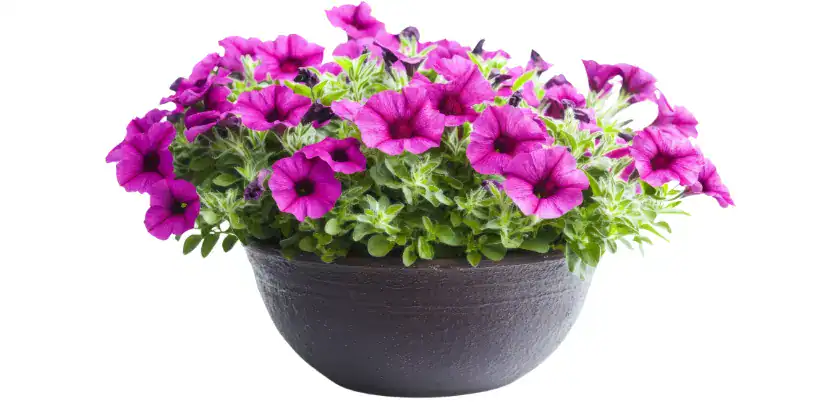
A neatly potted petunia plant.
FAQs: Petunia Care
Q: How often should I water my petunias in Southern California?
It depends on your location. Coastal areas may only need watering 1-2 times a week, while hot inland or desert regions may require watering every 2-3 days. Always check the soil first.
Q: Why are my petunia leaves turning yellow?
Yellowing leaves can indicate overwatering or a nutrient deficiency, usually nitrogen. Ensure the soil is well-draining and fertilize regularly.
Q: Do I need to deadhead my petunias?
Yes, for most varieties. Deadheading encourages continuous blooming. Some newer hybrids like Supertunias are “self-cleaning” and don’t require it as much, but it can also keep the plant looking tidy.
Q: What’s making my petunias “leggy”?
Legginess (long, sparse stems with few flowers) is usually caused by insufficient sunlight or a lack of pruning. Move the plant to a sunnier spot and trim it back to encourage bushier growth.
5. Can petunias survive a Southern California winter?
In mild, frost-free coastal areas, petunias can often survive the winter and act as short-lived perennials. In colder inland and mountain areas, they’re typically grown as annuals.
Q: Are petunias deer-resistant?
No. If you have deer in your area, it’s best to plant petunias in protected spaces, such as hanging baskets on a porch or in a fenced yard.
Q: What are the best companion plants for petunias?
Petunias pair well with other sun-loving annuals like geraniums, marigolds, verbena, and calibrachoa (million bells).
Q: How do I keep my hanging basket of petunias looking full?
Water and fertilize regularly, as hanging baskets dry out quickly. Rotate the basket periodically so all sides get sunlight, and don’t be afraid to give plants a “haircut” mid-season to rejuvenate growth.

